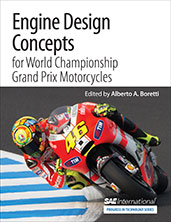Technical Paper
A Naturally Aspirated Four Stroke Racing Engine with One Intake and One Exhaust Horizontal Rotary Valve per Cylinder and Central Direct Injection and Ignition by Spark or Jet
2015-03-10
2015-01-0006
The paper discusses the benefits of a four stroke engine having one intake and one exhaust rotary valve. The rotary valve has a speed of rotation half the crankshaft and defines an open passage that may permit up to extremely sharp opening or closing and very large gas exchange areas. The dual rotary valve design is applied to a racing engine naturally aspirated V-four engine of 1000cc displacement, gasoline fuelled with central direct injection and spark ignition. The engine is then modeled by using a 1D engine & gas dynamics simulation software package to assess the potentials of the solution. The improved design produces much larger power densities than the version of the engines with traditional poppet valves revving at higher speeds, with reduced frictional losses, and with larger gas exchange areas while also improving the fuel conversion efficiency thanks to the sharpness of opening or closing events.

